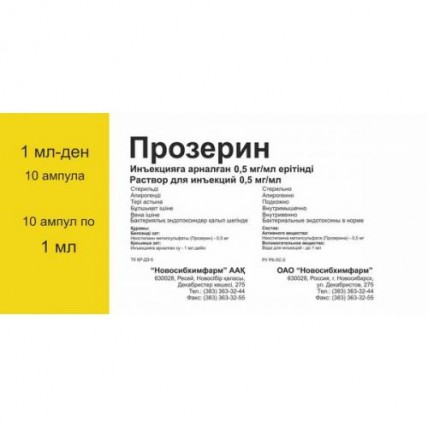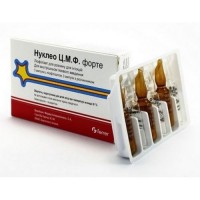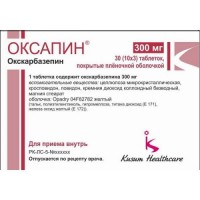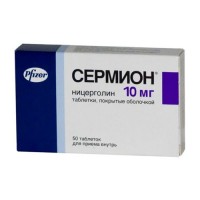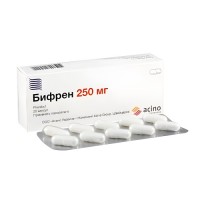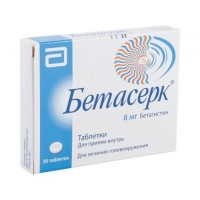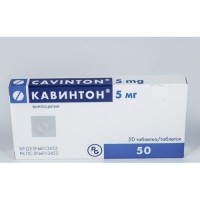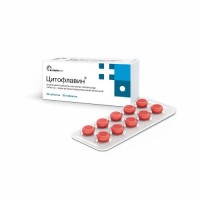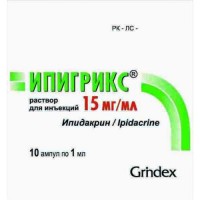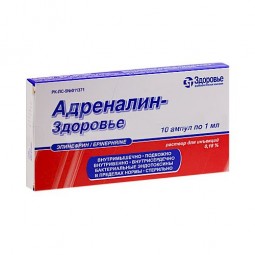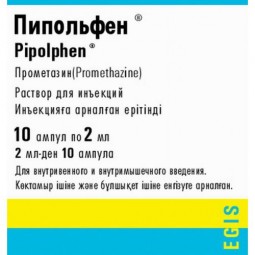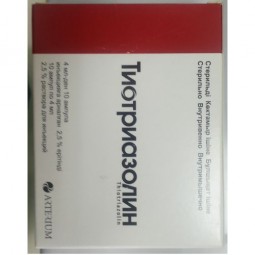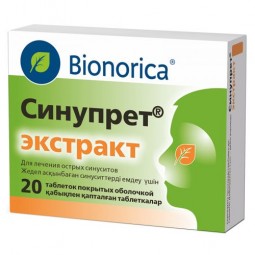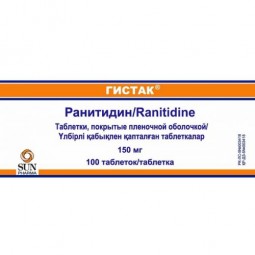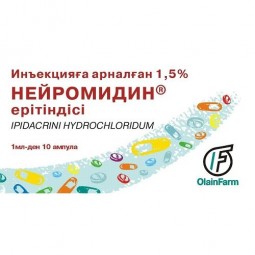Prozerin (Neostigmine) 0.05%/ml, 1 ml x 10 ampoules
- $6.00
The instruction for medical use of Prozerin Torgovoye medicine a name Prozerin Mezhdunarodnoye the unlicensed name Is not present the Dosage form Solution for injections, 0.5 mg/ml, 1 ml Structure of 1 ml of drug contains active agent – a neostigmin methyl sulfate (Prozerin) of 0.5 mg, excipient: water for injections. The description Colourless transparent liquid Pharmacotherapeutic group Drugs for treatment of diseases of nervous system others. Antikholinesterazny drugs. Neostigmin. The ATX N07AA01 code the Pharmacological Pharmacokinetics Being properties the quarternary ammonium basis, badly gets through a blood-brain barrier and has no central effect. The bioavailability of a neostigmin of methyl sulfate is 1-2%. At intramuscular introduction time of achievement of the maximum concentration in blood plasma – 30 minutes. Communication with proteins of blood plasma - 15-25%. Elimination half-life at intramuscular administration of drug is equal to 51-90 min., at intravenous – 53 min. It is metabolized in a liver by microsomal enzymes with formation of inactive metabolites. Removal: 80% of the entered dose are brought by kidneys during 24 h (out of them 50% in an invariable look and 30% in the form of metabolites). After intramuscular introduction the maximum effect is observed in 10-30 min., and after intravenous - in 5-15 min. Effect duration - 2.5-4 h. Pharmacodynamics Synthetic inhibitor of cholinesterase. Reversibly blocks cholinesterase that leads to accumulation and strengthening of action of acetylcholine on bodies and fabrics and to recovery of neuromuscular conductivity. Causes an urezheniye of heart rate, increases secretion of glands (salivary, bronchial, stalemate and digestive tract) and contributes to the development of hypersalivation, a bronchorrhea, increase in acidity of gastric juice, narrows a pupil, causes an accommodation spasm, reduces intraocular pressure, strengthens a tone of smooth muscles of intestines (strengthens a vermicular movement and relaxes sphincters) and a bladder, causes a spasm of bronchial tubes, raises a tone of skeletal muscles. Indications - a myasthenia - motive disturbances after brain injuries - paralyzes - the recovery period after the postponed meningitis, poliomyelitis, encephalitis - neuritis - prevention and treatment of an atony of digestive tract and bladder - weakness of patrimonial activity (seldom). - as antidote after anesthesia using not depolarizing muscle relaxants in muscle weakness and respiratory depression. In children's practice apply only at gravis myasthenia. Route of administration and doses Subcutaneously, intramusculary, intravenously. The adult usually appoint subcutaneously 0.5 mg (1 ml of solution) of a prozerin 1-2 times a day, the maximum single dose – 2 mg, daily – 6 mg. At development of myasthenic crisis in adults the drug is administered intravenously (from 0.9% chloride sodium solution) - 0.25-0.5 mg (0.5-1 ml of solution), then under skin in usual doses with small intervals. Treatment of a myasthenia is carried out it is long. In other diseases the course of treatment proceeds 25-30 days, if necessary the course of treatment is repeated after 3-4 week breaks. For stimulation of childbirth it is possible to enter under skin 0.5 mg (1 ml of solution) of a prozerin 1-2 times with intervals 1 hour, along with the first injection enter once under skin 1 mg (1 ml of 0.1% of solution) of atropine. At use of drug for stopping of action of not depolarizing muscle relaxants previously enter atropine intravenously in a dose of 0.5-0.7 mg (0.5-0.7 ml of 0.1% of solution), expect increase of pulse and in 1.5-2 minutes enter intravenously 1.5 mg (3 ml of solution of 0.5 mg/ml) of drug. If the effect of this dose was insufficient, enter a repeated same dose of drug (at appearance of bradycardia do an additional injection of atropine). In total it is possible to enter 5-6 mg (10-12 ml of solution) of drug within 20-30 minutes. At a postoperative atony of intestines, bladder: for prevention, including. postoperative ischuria – subcutaneously or intramusculary on 0.25 mg (0.5 ml of solution) of Prozerin, as soon as possible after operation, and repeatedly each 4-6 hours within 3 days, treatment of an ischuria – subcutaneously or intramusculary 0.5 mg (1 ml of solution) of Prozerin if during 1 h the diuresis is not restored, carry out catheterization and after bladder emptying each 3 h, only 5 injections enter. At children apply only at gravis myasthenia (only in the conditions of a hospital!) subcutaneously or intramusculary on 0.05 mg (0.1 ml 0.5 mg/ml of solution) for 1 year of life a day, but no more than 3.75 mg (0.75 ml 0.5 mg/ml of solution) on one injection. Usually to children drug is appointed once a day, however if necessary the daily dose can be divided into two-three introductions. Side effects from nervous system and sense bodys: headache, dizziness, spasms, weakness, loss of consciousness, drowsiness, miosis, disorder of vision, dysarthtia. From a cardiovascular system and blood (hemopoiesis, a hemostasis): arrhythmia, bradi- or tachycardia, atrioventricular block, a nodal rhythm, nonspecific changes on the electrocardiogram, a syncope, cardiac arrest, a lowering of arterial pressure (mainly at parenteral administration). From a respiratory system: strengthening of pharyngeal and bronchial secretion, short wind, respiratory depression up to a stop, a bronchospasm (mainly at parenteral administration). From bodies of digestive tract: hypersalivation, spastic reduction and strengthening of a vermicular movement of intestines, nausea, vomiting, meteorism, diarrhea. Other: a tremor, spasms and twitchings of skeletal muscles, including fastsikulyation of muscles of language, a spasm, a dysarthtia, an arthralgia, urination increase, plentiful sweating, allergic reactions (hyperaemia of the person, rash, an itching, an anaphylaxis). For removal of by-effects reduce a dose or stop drug use, if necessary atropine (1 ml of 0.1% of solution), a metotsiniya enter iodide or other holinoblokator. Contraindications - hypersensitivity to active ingredient - epilepsy - hyperkinesias - coronary heart disease - bradycardia, arrhythmias, stenocardia - bronchial asthma - the profound atherosclerosis - a hyperthyroidism - a peptic ulcer of a stomach and duodenum - peritonitis - mechanical obstruction of digestive tract and urinary tract - simultaneous use with the depolarizing muscle relaxants - a prostate hyperplasia - pregnancy, the lactation period. Use of drug is contraindicated in the period of acute infectious diseases, intoxication at sharply weakened children. Medicinal interactions of Neostigmin methyl sulfate is an antagonist of not depolarizing muscle relaxants, restores the broken neuromuscular conductivity. Therefore if after the anesthesia termination by not depolarizing muscle relaxants muscle weakness and respiratory depression remain, a neostigmina methyl sulfate apply as antidote of this group of muscle relaxants (an atrakuriya bezilat, a rokuroniya bromide, Tubocurarini chloridum, etc.). Neostigmina methyl sulfate and the depolarizing muscular relaxants (succinylcholine iodide, etc.) pharmacological are incompatible as in direct interaction the effect of succinylcholine of iodide amplifies. M-holinoblokatory (atropine, homatropine hydrobromide, Platyphyllinum, etc.), ganglioblokator (Pachycarpinum hydroiodide), quinidine, novokainamid, local anesthetics are pharmacological antagonists of a neostigmin of methyl sulfate. Between tricyclic antidepressants, antiepileptic and protivoparkinsonichesky means there is a relative antagonism. Cyanocobalamine in high doses weakens action of a neostigmin of methyl sulfate. In interaction of a neostigmin of methyl sulfate with a pyridoxine the activity of the last decreases. Cholinesterase inhibitors in combination with strychnine considerably raise a tone of vagus nerve, with laxatives – strengthen their action, with antiarrhythmic drugs (β-adrenoblockers) are synergists (aggravation of bradycardia). Ephedrine exponentiates action of a neostigmin of methyl sulfate therefore in myasthenic crises it is entered together with neostigminy methyl sulfate. Special instructions of Neostigmin methyl sulfate in direct interaction enhances effect of the depolarizing muscle relaxants (for example, iodide succinylcholine, etc.). However, in case of use of the depolarizing muscle relaxants in high doses, after the depolarizing action the anti-depolarizing effect (so-called "double block") develops therefore Prozerin's appointment can be reasonable in case of disturbances of breath and long muscle weakness after use of high doses of the depolarizing muscle relaxants. Pregnancy and the period of a lactation Use of drug is contraindicated at pregnancy and during breastfeeding. Children children can use Drug only in the conditions of a hospital. The feature of influence of medicine on ability to run the vehicle or potentially dangerous mechanisms during treatment needs to refrain from driving of motor transport and occupations potentially dangerous types of activity demanding the increased concentration of attention and speed of psychomotor reactions. Overdose Symptoms: hypersalivation, pouring sweat, abdominal pain, diarrhea, breath difficulty, bradycardia, cyanosis, miosis, twitching of skeletal muscles, muscle weakness. Treatment: administration of drug should be stopped and to immediately enter atropine (1 ml of 0.1% of solution under skin) or other holinoblokator. In cases of a serious poisoning prozeriny, Atropini sulfas is entered with intervals of 10 minutes to 3 times (before emergence of dryness in a mouth). When developing spasms intravenous administration of thiopental of sodium under observation of the doctor. A form of release and packing On 1 ml in ampoules of neutral glass. On 10 ampoules in a box of cardboard. Put the instruction for medical use in each box in the state and Russian languages and a knife for opening of ampoules or the scarificator ampoule. When packing ampoules with a ring of a break or a point of a break the knife for opening of ampoules or the scarificator ampoule is not put. To Store storage conditions in the place protected from light at a temperature from 15 to 25 °C. To store out of children's reach! 4 years not to apply a period of storage after the expiration date specified on packing Prescription status According to the prescription JSC Novosibkhimfarm Producer 630028, Russia, Novosibirsk, Dekabristov St., 275 ph. (383) 363-32-44, fax (383) 363-32-55 Holder of the registration certificate of JSC Novosibkhimfarm 630028, Russia, Novosibirsk, Dekabristov St., 275 ph. (383) 363-32-44, fax (383) 363-32-55 The address of the organization accepting claims for territories of the Republic of Kazakhstan from consumers on quality of the products (goods) responsible for post-registration observation of safety of medicine: Valenta Aziya LLP, Almaty, ave. of Abay, ug. Radostovts St., 151/115, office No. 1102
to Develop the business center Ala Tau
to Develop the business center Ala Tau
